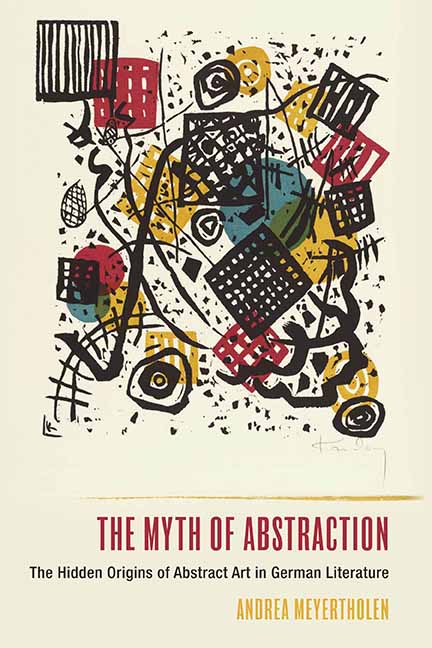Book contents
- Frontmatter
- Dedication
- Contents
- List of Illustrations
- Acknowledgments
- Introduction: The Many Origins of Abstract Art
- 1 Apocalypse Now: Heinrich Von Kleist’s Sublime Deframing of Caspar David Friedrich’s Der Mönch Am Meer (1810)
- 2 The Kleistian Sublime Is Now: Kazimir Malevich, Mark Rothko, Barnett Newman
- 3 The Clouding of Perception: Seeing The (Un)Real Potential for Abstraction in the Poetry and Science of Goethe’s Clouds (1821)
- 4 In the Service of Clouds or Optical Illusion?: Romanticism, Pointillism, and Impressionism
- 5 Driven to Distraction and from Abstraction: The Birth and Death of Abstract Art in Gottfried Keller’s Der Grüne Heinrich (1854/55, 1879/80)
- 6 Inside the Mind and Outside the Margins: The Unruly Lines of Paul Klee, André Masson, and Cy Twombly
- Epilogue: Laocoön and His Sisters: The Future of Literature and Art
- Bibliography
- Index
3 - The Clouding of Perception: Seeing The (Un)Real Potential for Abstraction in the Poetry and Science of Goethe’s Clouds (1821)
Published online by Cambridge University Press: 07 May 2022
- Frontmatter
- Dedication
- Contents
- List of Illustrations
- Acknowledgments
- Introduction: The Many Origins of Abstract Art
- 1 Apocalypse Now: Heinrich Von Kleist’s Sublime Deframing of Caspar David Friedrich’s Der Mönch Am Meer (1810)
- 2 The Kleistian Sublime Is Now: Kazimir Malevich, Mark Rothko, Barnett Newman
- 3 The Clouding of Perception: Seeing The (Un)Real Potential for Abstraction in the Poetry and Science of Goethe’s Clouds (1821)
- 4 In the Service of Clouds or Optical Illusion?: Romanticism, Pointillism, and Impressionism
- 5 Driven to Distraction and from Abstraction: The Birth and Death of Abstract Art in Gottfried Keller’s Der Grüne Heinrich (1854/55, 1879/80)
- 6 Inside the Mind and Outside the Margins: The Unruly Lines of Paul Klee, André Masson, and Cy Twombly
- Epilogue: Laocoön and His Sisters: The Future of Literature and Art
- Bibliography
- Index
Summary
MODERN SUBJECTIVITY and the importance of Goethe for its formation has long been an acknowledged object of scholarly investigation. Emerging from the shifting paradigms transforming late eighteenth-century European culture, Goethe's literary portrayals of how a newly interiorized self with a greater sense of freedom and autonomy struggles to relate to society have prompted Michel Foucault, Friedrich Kittler, and Marshall Berman to single out the author as an early voice of modernity.
Others have pointed to Goethe's work in the natural sciences, which, though underappreciated by his contemporaries, seems to anticipate discourses of the twentieth century. Depending on disciplinary perspective, Goethe's subject heralds or embodies the idea of modernity and the modern subject in what Jane K. Brown calls a “variety of mutually complementary forms,” be they sociological, philosophical, or scientific. Of importance here is the final form and how it compliments another such form, that of modern aesthetics and abstract art.
Although the long nineteenth century separates the advent of abstraction from Goethe's poetry and writings on science, the two are nevertheless connected by a specific mode of viewing crucial for the existence of abstract art. Goethe's conception of the subject as an embodied observer who actively engages sensory organs and cognitive faculties to understand the natural world also marks the birth of a subject capable of assuming a critically significant degree of responsibility and subjectivity in aesthetic encounters. This, in turn, provides a theoretical basis for the abstract art that becomes historical reality in the early twentieth century. The structural underpinnings of this mode of viewing are already explicated by Goethe in 1792 in the essay “Versuch als Vermittler von Objekt und Subjekt” (“The Experiment as Mediator between Object and Subject”), where the poet articulates a scientific methodology contingent on the human body and cognition. However, it is not until Goethe deploys his method of scientific viewing for the purposes of aesthetic pleasure in the stanzas of his cloud poem “Howards Ehrengedächtnis” (“In Honor of Howard”) in 1821 that the inception of a new mode of cognitive spectatorship— a “clouding of perception”—comes about and reconfigures the way an individual is willing to think about what constitutes art and an aesthetic experience.
- Type
- Chapter
- Information
- The Myth of AbstractionThe Hidden Origins of Abstract Art in German Literature, pp. 99 - 137Publisher: Boydell & BrewerPrint publication year: 2021



